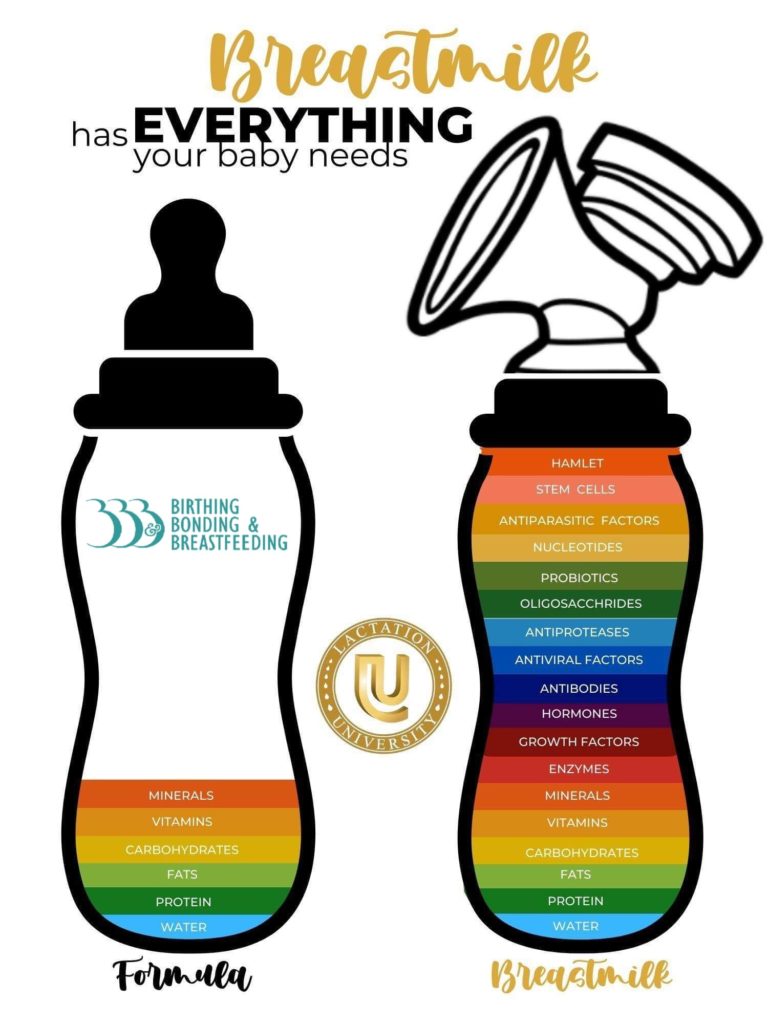How does breastmilk differ from formula?
As a breastfeeding mom and a lactation consultant I have heard both “breast is best” and “fed is best” saying in (almost) daily life, but what is the actual difference between breastmilk and formula? Are they comparable? Can formula contain every nutrient that breastmilk contains?
No!
When it comes to breastmilk and formula, there are six different parts that are the same. This includes water, protein, fats, carbohydrates, vitamins, and minerals. Outside of these six basic components, breastmilk includes 12 additional components. Check out this amazing graphic from Lactation University!

“Outside of the six essential components that are found in breastmilk and formula, breastmilk contains an additional 12 components.”

As you look through the list, there are some of the typical components that we all hear about, like enzymes and antibodies, but what are oligosaccharides, and hamlet cells?
Oligosaccharides, also known as human milk oligosaccharides (HMO), are designed to help coat the lining of the gastrointestinal tract, are responsible for boosting the infant’s immune system, and fighting against infection (Hegar et.al, 2019). HMOs act as very early prebiotics for infants and there are over 200 different types of HMOs (Vandenplas, et. al, 2018). This is one big way that breastmilk differs from the formula. HMOs are included in some formulas, however, these are artificial HMOs and the FDA only approves two HMOs to be added to infant formula.
Hamlet Cells, in my opinion, are one of the most amazing parts of breastmilk. Hamlet Cells are made of proteins and fatty acids. They are able to do the impossible- attack cancer cells! Yes, you read that right, these cells are able to attack and kill cancer cells and repair organs. There have been clinical trials that show hamlet cells are able to kill 40 different types of cancers.
With these two different types of cells, it is very obvious that formula does not stand up to breastmilk. While I am realistic, I understand that some moms have their reasons for not breastfeeding. Feeding their baby is the number one thing that they need to do so there need to be other options. This is a great reason why donor breastmilk needs to continue to gain traction in the healthcare world.
References
Hegar, B., Wibowo, Y., Basrowi, R. W., Ranuh, R. G., Sudarmo, S. M., Munasir, Z., Atthiyah, A. F., Widodo, A. D., Supriatmo, Kadim, M., Suryawan, A., Diana, N. R., Manoppo, C., & Vandenplas, Y. (2019). The Role of Two Human Milk Oligosaccharides, 2′-Fucosyllactose and Lacto-N-Neotetraose, in Infant Nutrition. Pediatric gastroenterology, hepatology & nutrition, 22(4), 330–340. https://doi.org/10.5223/pghn.2019.22.4.330
Vandenplas Y, Berger B, Carnielli VP, Ksiazyk J, Lagström H, Sanchez Luna M, Migacheva N, Mosselmans JM, Picaud JC, Possner M, Singhal A, Wabitsch M. Human Milk Oligosaccharides: 2′-Fucosyllactose (2′-FL) and Lacto-N-Neotetraose (LNnT) in Infant Formula. Nutrients. 2018 Aug 24;10(9):1161. doi: 10.3390/nu10091161. PMID: 30149573; PMCID: PMC6164445.

